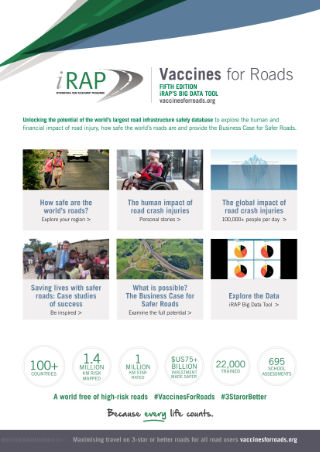Guide for Road Safety Opportunities and Challenges: Low and Middle-Income Country Profiles
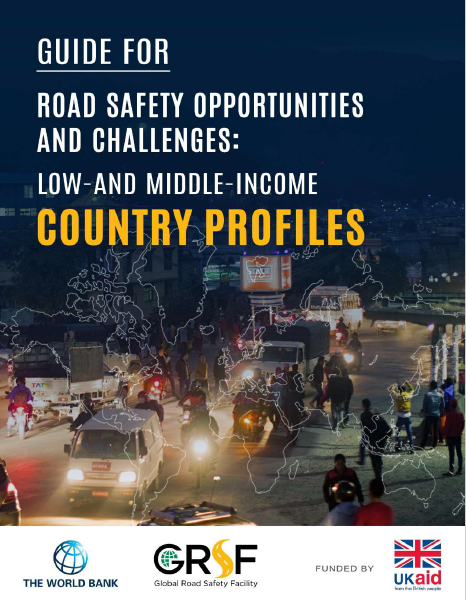
The Guide for Road Safety Opportunities and Challenges: Low and Middle-Income Country Profiles, is the first data report to cover all 125 LMICs with comprehensive road safety country profiles. The profiles present information on each pillar of road safety—management, roads, speed, vehicles, road users, and post-crash care—, to help countries and development practitioners identify challenges and opportunities, and monitor progress. The guide gives a precise assessment on the magnitude and complexity of road safety challenges faced by LMICs and helps policy makers understand the road safety framework in context of their own country systems and performance.
This report responds to the critical need for collecting and documenting accurate road safety performance data. It assembles information from multiple important and high-quality sources to take stock of any given country’s past achievements on road safety, establishing a baseline for the next decade of action across many areas of policy and performance.
The Guide for Determining Readiness for Speed Cameras and Other Automated Enforcement is particularly designed to address the questions of many countries who are considering the introduction of a speed camera program, or similar automated system. These technologies are, on the whole, effective, but require extensive ground work to ensure their benefits - and many countries have not yet engaged in this ground work but are considering these systems.
Questions a country must answer prior to implementing automated enforcement systems can include: are most vehicles registered? Do they have a readable identification/number/registration plate for the camera? Do records allow for the owner/driver to be contacted through their home address or mobile number?
For countries not yet prepared for automated enforcement systems, this guide sets out a path of development and lists the necessary areas of focus prior to the introduction of speed cameras. Like any system, it is important not to expect perfection from speed cameras or similar systems, only a reasonable level of performance.
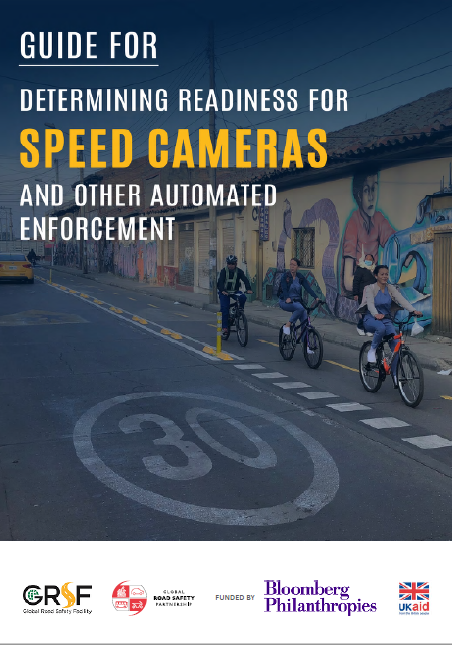
Practical Road Safety Engineering Workshop, July to August 2020
Contact Person
UN General Assembly Resolution on Road Safety - August 2020
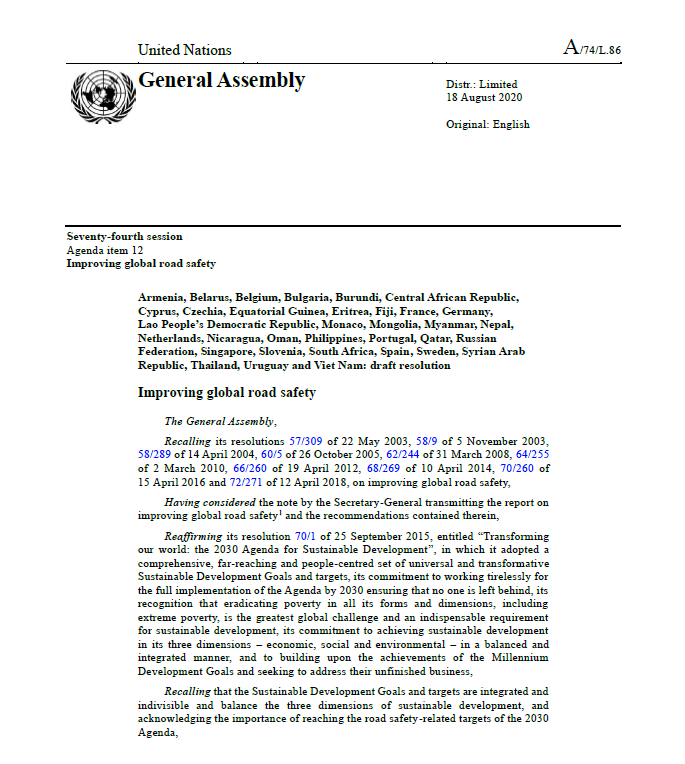
The UN General Assembly has adopted a new resolution on global road safety, recalling that the Sustainable Development Goals are integrated and indivisible, and acknowledging the importance of reaching the road safety-related targets of the 2030 Agenda.
Video Message by Bambang Susantono - First Workshop on the Implementation of the Asia Pacific Road Safety Observatory
Every day, more than 3,500 people die in road crashes worldwide; 100,000 or more are injured or disabled. Road trauma is a serious and ongoing public health crisis. Crash costs are typically 2-5% of national GDP each year, impacting every country on earth. In particular, this crisis affects developing countries, where 9 out of 10 road deaths occur.
The United Nations has included road safety as a Sustainable Development Goal (3.6) setting the challenge of halving the number of global deaths and injuries from road traffic crashes by 2020. In addition, the UN Global Road Safety Performance Targets include objective and achievable targets for all new roads to be built to a 3-star or better standard for all road users (Target 3), and more than 75% of travel is on the equivalent of 3-star or better roads for all road users by 2030 (Target 4). iRAP believes that road death and injury is preventable and that the solutions exist. Improving the world’s roads to a 3-star or better standard for all road users is a key way to meet the UN targets in combination with action across all the established road safety pillars. Achieving >75% of travel on 3-star or better roads by 2030 will save an estimated 467,000 lives every year.
iRAP’s systematic approach can help save thousands of lives. It involves simple, affordable improvements to road infrastructure and speed management that can dramatically reduce both the risk of crashes occurring and their severity.
iRAP programmes can be easily integrated into existing or new road safety initiatives in a country:
- Risk Maps provide a global standard to measure and benchmark historical crash performance and target action;
- Star Ratings provide an objective, evidence-based global measure of the safety of infrastructure for pedestrians, cyclists, motorcyclists and vehicle occupants;
- Safer Road Investment Plans can help shape an upgrade programme and Safer Roads Fund that will maximise lives saved per unit of investment; and
- Policy and performance tracking tools provide agencies with the ability to measure and manage success.
This brochure is designed to help countries develop their own locally owned and led national or state programmes and develop and deliver projects that save lives.
iRAP is a member of the United Nations Road Safety Collaboration and Global Alliance of NGOs for Road Safety and works closely with the World Health Organisation, FIA Foundation, World Bank, International Transport Forum, PIARC, OECD and other road safety stakeholders to support and coordinate global action across all pillars of action on road safety.
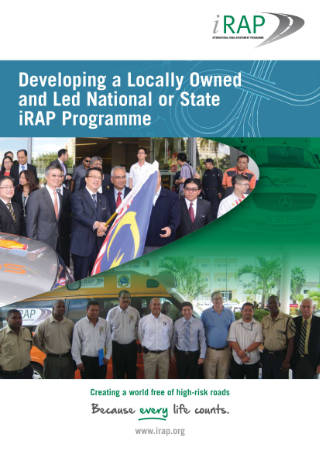
The Ten Step Plan for Safer Road infrastructure has been produced by the United Nations Road Safety Collaboration partners to support countries seeking to implement initiatives in relation to the “Improved safety of road infrastructure and broader transport networks”, the UN Convention on Road Traffic and Road Signs and Signals and the achievement of UN Member States Agreed Global Targets 3 and 4 for safer new and existing roads.
Target 3 states that “by 2030, all new roads achieve technical standards for all road users that take into account road safety or achieve a three-star rating or better”. Target 4 states that “by 2030, more than 75% of travel on existing roads is on roads that meet technical standards for all road users that take into account road safety.”
The Ten Step Plan for Safer Road Infrastructure will build the institutional capacity and regulatory framework to support these targets and unlock the potential of safer roads and safer cities to save lives. With the support of UN agencies and the UN Road Safety Fund, countries can mobilise international partnerships and collaboration to ensure that no new high-risk, one or two-star roads are constructed, and existing roads and city streets are targeted in a cost-effective manner to maximise the amount of travel on roads that are safe for all pedestrians, cyclists, motorcyclists and vehicle occupants.
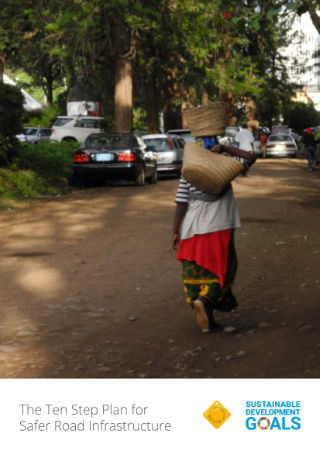
Towards the 12 voluntary global targets for road safety: Guidance for countries on activities and measures to achieve the voluntary global road safety performance targets
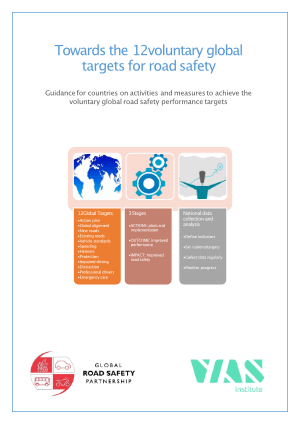
This document acts as a guide to assist countries to monitor and report on the 12 Voluntary Global Road Safety Performance Targets, on which a consensus had been reached during a meeting of WHO Member States held in November 2017 in Geneva, Switzerland.
The voluntary global performance targets for road safety risk factors and service delivery mechanisms are a means to enable countries to monitor and report on progress on road safety efforts. This timely document provides guidance to countries on how to operationalize and utilize these targets. It spells out what type of activities need to be undertaken, what data sources can be used and how performance can be measured and presented. It defines each target and points out what actions need to be taken and how each target can be measured.
First Workshop of the Asia-Pacific Road Safety Observatory (APRSO)
Contact Person
Pagination
- Previous page
- Page 5
- Next page
